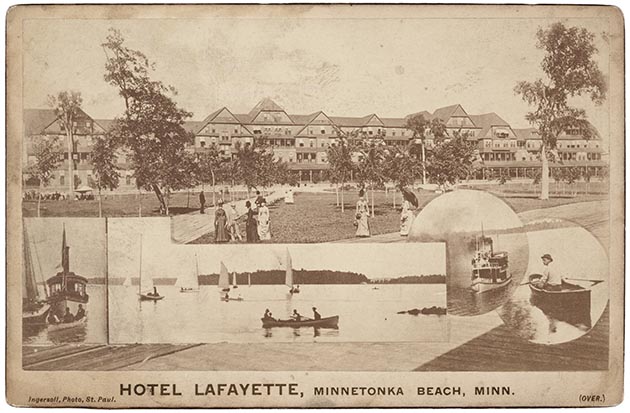In the late 19th century, Lake Minnetonka became an incredibly popular vacation spot for the nation’s elite. Vacationers were eager to exchange the summer heat for a retreat to Minnetonka, “a climate made pure and health-giving by the rarified air of a high altitude and cooled by the grateful winds of the North” as the National Health Journal wrote in 1899.
Minnetonka’s vacation boom started after the Civil War as railroads grew and crisscrossed the country, making it easier for vacationers to reach Minnesota. By the 1880s, Lake Minnetonka was becoming well-known for its array of resort hotels, where visitors could go fishing, yachting and much more.
The hotels catered mostly to wealthy visitors, and the St. Paul and Minneapolis newspapers frequently published lists of the notable guests and where they were staying.

Flocking to Minnesota
St. Louis attorney Charles Gibson is often credited with spurring the Lake Minnetonka area’s popularity. After building a vacation home on the lake in 1870, he oversaw construction of the luxurious Hotel St. Louis in Deephaven in 1879. The hotel had 200 rooms, verandas on every floor and modern amenities such as telephones and electricity.
Another grand hotel that opened that same year was the Lake Park Hotel.
Built by the Northwestern Sunday School Association, it was originally envisioned as a retreat for Sunday school conventions and temperance advocates. But after one season, it transitioned to a tourist hotel, complete with a fleet of boats, baseball grounds, a roller rink and space for summer operas and plays.
Hotel Lafayette
But the lake’s largest-ever hotel was the Hotel Lafayette at Minnetonka Beach. The 700-foot, Queen Anne-style hotel boasted five floors, some 300 rooms and sat on a peninsula, giving every room a view of the lake. Guests could entertain themselves in a billiard hall, bowling alley and saloon. And the hotel’s 250-foot dock welcomed various steamboats that regularly crossed the lake.
The Lafayette was the creation of St. Paul railroad baron James J. Hill, who operated the Great Northern Railway. The day after the hotel opened on July 2, 1882, Hill also launched the Belle of Minnetonka, the lake’s largest steamboat, able to haul 2,500 passengers. His railroad also ran its lines straight to the hotel, which claimed the title of the “largest hotel used exclusively for summer business in the world,” according to the St. Paul Daily Globe in 1885.
The Lafayette’s grandeur reached its peak in September 1883 when Hill and his colleagues threw a party at the hotel to celebrate the completion of the Great Northern Railroad, which stretched from St. Paul to Seattle.
More than 500 guests from around the world attended the celebration, including President Chester A. Arthur, former president Ulysses S. Grant, nine governors, various foreign ministers and an assortment of notable Minnesotans, including Alexander Ramsey, Henry Sibley, Thomas Lowry and Cass Gilbert. Coverage of the party, including the menu, guest list and seating chart, filled nearly two full pages of the St. Paul Daily Globe the next day.
A Southerner’s escape
The summer of 1883 was the height of popularity for Lake Minnetonka’s hotels, with the three biggest hotels — the Lafayette, St. Louis and Lake Park — drawing in 10,000 guests in July and August and 90,000 tourists overall.
Many of the people flocking to Minnesota for the summer in the early 1880s were Southerners trying to escape an outbreak of yellow fever at home.
With the surge in Southern tourism, the Hotel Lafayette expanded its accommodations. But when the yellow-fever threat waned, the large hotel was never fully booked again, except on special occasions.
As the area hotels’ income fell, many tried to find ways to attract crowds again. In 1892, the Lafayette invited tourists to a lavish Fourth of July celebration complete with performances by the Great Western Band, eight special trains to take tourists to the hotel and an elaborate fireworks display.
In 1893, the nation was hit with an economic crisis, and the number of vacationing tourists in Minnetonka only continued to slump. Another issue was the growing railroad system; trains had originally brought vacationers to Minnetonka, but as the railways expanded, people were able to vacation all around the country.
The 1890s also marked the beginnings of automobile tourism in the U.S.

A devastating fire
The Hotel Lafayette survived for most of the 1890s, but met an unexpected end on Oct. 4, 1897 when it suddenly caught fire. The blaze was noticed around 11 a.m., but attempts to put it out seemed to be stopped at every turn.
The hotel’s water was turned off for the season, and the nearby telegraph office was also closed. When word of the fire finally spread, a fire engine and crew set out — but had to come from Minneapolis. By the time they arrived, the hotel was in ruins, and anything within 500 feet of the building was burned.
James J. Hill chose not to rebuild the hotel. Within a few decades, most of Minnetonka’s other grand hotels also disappeared from the lakeshore; the Hotel St. Louis was demolished in 1907 and the Lake Park Hotel closed in 1911. In 1899, the site of the Hotel Lafayette was deeded to the founders of the Lafayette Club, a private club that still exists today in Minnetonka Beach.

